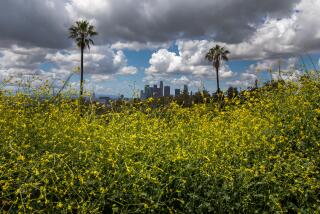WHAT’S FRESH : BUYING OPPORTUNITIES : Spice of Leaf : Cilantro, parsley’s zesty cousin, is easy to grow, but watch out if you bruise the coriander seeds.
- Share via
It resembles parsley in color and appearance, but the smell and taste of cilantro make it a far cry from its blander, parsley relative.
Cilantro, which comes from the coriander plant, was popular with the ancient Romans, who introduced it to the rest of Europe as a slightly bitter-tasting, aromatic herb to flavor cakes, cookies, pastries, sausages and liqueurs.
Cilantro leaves--feathery, dark green and saw-toothed in appearance--are different from coriander, which are dried, finely ground, yellow seeds from the coriander plant, also used for seasoning.
Both cilantro and coriander are favored in Chinese, Indian and Mexican cuisines. Cilantro leaves are often a main ingredient in salsas, and in earlier times, sugar-coated coriander seeds were a popular candy in Scotland.
“It’s harder to grow it in the summer than in winter,” said Charlie Aaron, sales manager of Muranaka Farms in Moorpark. “It doesn’t like hot weather.” Ventura County, with its coastal influence, is not as warm as some areas, so cilantro can be grown in the summer, Aaron said. The coriander plant is native to the eastern Mediterranean, and California’s weather is similar to the Mediterranean climate.
Growing the plant is relatively easy, Aaron said. “There’s no trick to it, you just have to watch it pretty closely.”
Plant coriander seed eight to 10 inches apart and a half inch deep in moderately rich soil and give it lots of water. In 45 to 90 days, or when the plant is four to six inches tall, the cilantro leaves are ready for picking, Aaron said.
The plant goes to seed relatively quickly, so to ensure a steady supply of cilantro, Aaron recommended starting new plants every few weeks.
But home growers should be warned. According to the World Encyclopedia of Food, the name coriander derives from the ancient Greek word for bedbug because its seeds, if bruised in the unripe state, give off a revolting smell. “Pick the leaves before the plant goes to seed,” Aaron advised.
Fish aficionados know that Alaskan halibut season recently opened, and the catch this year has been superb so far, said Joe Carabajal, manager of Otani Izzy Fish Market in Oxnard. The season will continue through August.
Tuna and albacore, a white-meat tuna, are also beginning to make an appearance from San Diego to Long Beach and are being trucked up the coast, Carabajal said. Good local catches, he said, are red snapper and bass.
More to Read
Eat your way across L.A.
Get our weekly Tasting Notes newsletter for reviews, news and more.
You may occasionally receive promotional content from the Los Angeles Times.










